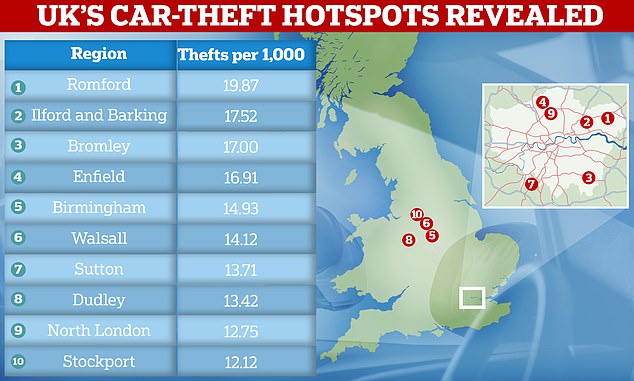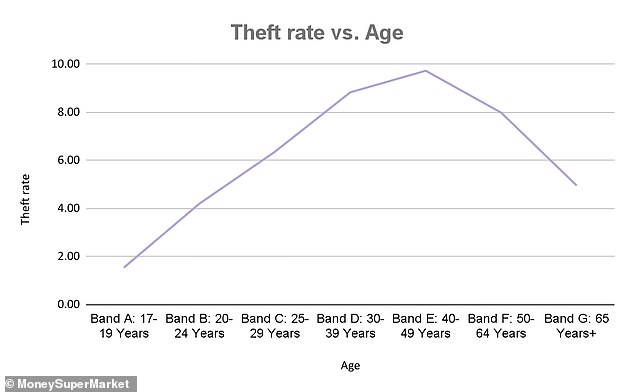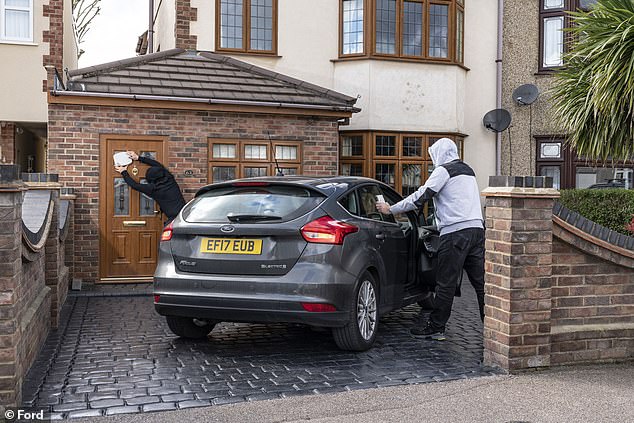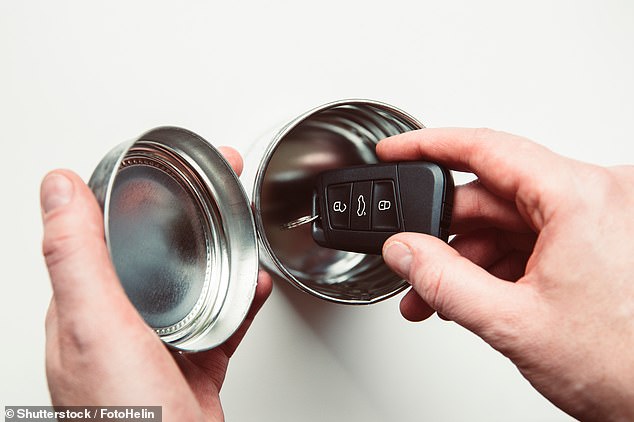
Britain’s car theft capital has been named as Romford, in East London, taking the mantle from neighbouring Ilford, which had earned the unwanted crown last year.
The locations with the worst record for stolen motors were identified by analysing the number of motorists per area who reported a vehicle pinched in the last five years.
Data from 16 million insurance enquiries in the last year found that 19.87 of drivers per 1,000 in the large town in the London Borough of Havering had made a claim after their car was stolen, which is more than anywhere else in the country, says MoneySuperMarket.

Car-theft capital of Britain: Romford has been named the nation’s hotspot for stolen vehicles, according to the latest analysis carried out by a comparison website
Romford’s ‘car theft rate’ – based on data collected in the 12 months between September 2020 and September 2021 – was up on last year’s figure of 19.1 per 1,000 enquiries.
In contrast, Ilford, which was last year’s car-theft hotspot, saw a decline of 2.78, dropping it down to second place in the standings with a theft rate of 17.52 for every 1,000 enquires made.
Bromley in South East London claimed third place with a car theft rate of 17.00, followed by Enfield in North London (16.91), and Birmingham (14.93).
At the safest end of the table, Inverness in the north of Scotland reported a car theft rate of just 0.08, followed by another Scottish town, Dumfries and Galloway (0.36) and Llandrindod Wells in Wales (0.47).

Romford in East London has been named the UK’s car-theft capital, taking the mantle from neighbouring Ilford, which had earned the unwanted crown last year
When analysed by region, London is the least secure region for people’s motors, with a car theft rate of 11.55 per 1,000 enquiries.
The West Midlands is next, with 10.94 per 1,000, followed in third by the North West (7.31).
Northern Ireland was by far the safest region in the UK, with a car theft rate of just 1.87 per 1,000.
The comparison site’s report also found that there is some correlation between a driver’s age and the likelihood of having their motor pinched.
Its data shows that car theft rates peak for motorists between the ages of 40 and 49 and declines towards old age.
MoneySuperMarket says this suggests drivers around middle-age are most likely to own a car that’s desirable and therefore attractive to thieves, while those in their later years are perhaps driving something a little more sensible and less appealing to criminals.

MoneySuperMarket says there is correlation between the age of a vehicle owner and the likelihood of having their car stolen, with motorists ages 40-49 years most at risk, likely because they are driving more desirable vehicles
Sara Newell, car insurance expert at MoneySuperMarket, said Romford’s naming at the top of the car-theft order will likely impact premiums for motorists in this area.
‘One thing that insurers consider when calculating your premium is your location, and it can impact the cost of your cover,’ she said.
‘Car insurance will help minimise the financial impact of theft, so when your policy is up for renewal compare prices to make sure you’re getting the best deal for your policy – you could save up to £3,302.’
Five tips to protect your car from thieves
1. If your car has keyless tech, keep the fob well away from your vehicle and store it in a Faraday wallet
The latest – and most prevalent – type of vehicle theft at the moment is attacks on keyless cars.
Criminals use cheap technology to detect the signal from your car’s keyfob inside your house and then duplicate it to unlock and start the vehicle without raising an alarm.
If your car has keyless entry and keyless start features, you should place your keys or fob as far away from the vehicle as you can and store them in a location that is not near doors or windows in your property.

Keyless car thefts – or ‘relay’ thefts – are the most prevalent in the UK. Here’s how to protect yourself from falling victim to this type of crime
Even keeping them upstairs or in a room that’s the furthest distance from your driveway will not guarantee that a criminal using relay tactics won’t be able to infiltrate the fob.
For the best level of protection, owners of cars with keyless tech should purchase a Faraday pouch or wallet.
You can buy these online for as little as £5 (Halfords currently sells one for £4.50).
These isolate the key fob’s signal so to block devices commonly used by thieves to detect it to gain access to your vehicle.
Edmund King tells us to test the Faraday pouch when you buy it. Do this by putting the keys in the protective wallet and then approach the car to ascertain whether it is effective. ‘Sometimes if the pouch isn’t fully closed it doesn’t work,’ he claims.
Metal tins and boxes will also provide similar protective levels, as will keeping your key fob in a fridge freezer, microwave or oven – just remember they are in there before turning on the latter two.
Also, don’t forget about your spare keys and apply the same level of care you would to your main keys or fob.

Keeping your keyless fob in a tin will block the signal and prevent thieves from duplicating it to break into your vehicle
2. Invest in extra anti-theft protection for your vehicle
A simple steering wheel lock or wheel clamp might look ugly but are a great tool to deter even the hardiest criminals.
They will act as a visual deterrent for thieves who will likely avoid them.
For a criminal to remove a steering wheel lock typically requires the use of noisy drills or saws to cut through, and therefore they are the ideal first line of defence for owners with models that have keyless car tech.
Most steering wheel locks require a key, though Halfords recently launched the first fingerprint-activated lock, which costs £60, as part of a bid to cut down on the rising spate of keyless thefts.
Drivers should also consider wheel clamps as well as having alarm systems and trackers (read more about these below) installed.
Owners of vans with keyless technology should also consider fitting deadbolts for additional protection, especially if they store expensive tools and items in their commercial vehicles overnight.
3. Be mindful when locking the vehicle
It may sound simple but if your vehicle has keyless entry, make sure it is locked every time you’re not in it, even if it’s just for a couple of minutes when you’re paying to park somewhere – thieves can take an unlocked car in seconds.
When it comes to locking, many modern cars have keys with two settings – for single and double locking.
Many drivers don’t realise that on many models if you press your key fob once your car will only be single locked.
This means that if you smashed the window you could manually open the car by reaching in and pulling the handle from the inside.
These key fobs require a second pressing of the locking button to enable all security features. It is important to read your car’s manual when you first get it and familiarise how to securely lock your car when you’re not in it.
4. Think carefully about where you park overnight
Most often, keyless car thefts take place on owners’ driveways. While motorists might think having their vehicle in such close proximity to their property guarantees its security, this is certainly not the case when it comes to relay thefts – quite the contrary, in fact, as it means the car is closer to where they keys are inside your home.
That’s why owners with off-street parking should consider additional measures.
Driveway parking posts are a cheap but efficient way of deterring would-be thieves.
Drivers can also go one step further and install lockable gates in their driveway, while simple CCTV systems can provide further peace of mind.
Luxury cars, which are at greater risk of theft, should be parked in a locked garage where possible.
For those without off-street parking who leave their cars on the road outside their home, you are also not safe from these criminals.
Consider parking further away from your property than usual – and try to find a space under a street light so that thieves are exposed when trying to steal your car at night.
If you live on a residential street where there are also business, park outside one with a CCTV camera installed.
5. Install a tracking device in your car
Installing a tracker system in your vehicle, such as a Thatcham approved device, offers an extra layer of security.
A tracking device won’t stop your vehicle being stolen, but it significantly increases the chances of the police recovering and returning it to you.
Tracker, one of the biggest providers of these systems, says it has seen a year-on-year increase in vehicle thefts and recoveries in the opening six months of the year.
More than £5million worth of vehicles in the first half of 2022 were recovered by Tracker, an increase of 13 per cent compared to the same period in 2021.
It offers a variety of devices and packages, ranging from a battery-powered tracker from £249 to a £708 all-singing service that uses ‘military-grade’ technology to locate the whereabouts of a vehicle.
Range Rovers and Land Rovers were most commonly stolen and recovered by the company between January and June, accounting for four of the top models recovered. They also account for 44 per cent of all cars recovered by Tracker.
The other make and model taking a spot in Tracker’s top five list was the Mercedes-Benz C-Class.
Some links in this article may be affiliate links. If you click on them we may earn a small commission. That helps us fund This Is Money, and keep it free to use. We do not write articles to promote products. We do not allow any commercial relationship to affect our editorial independence.







